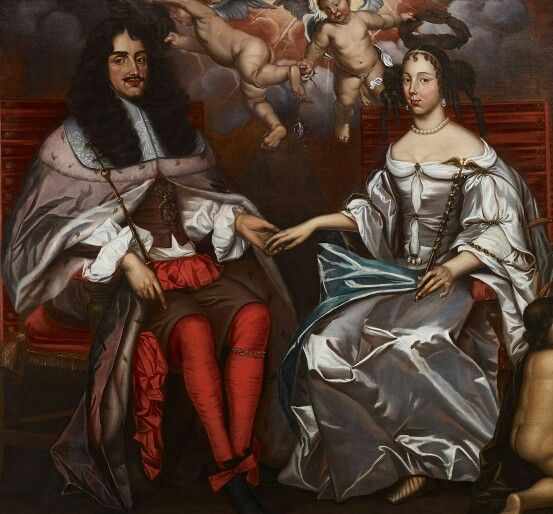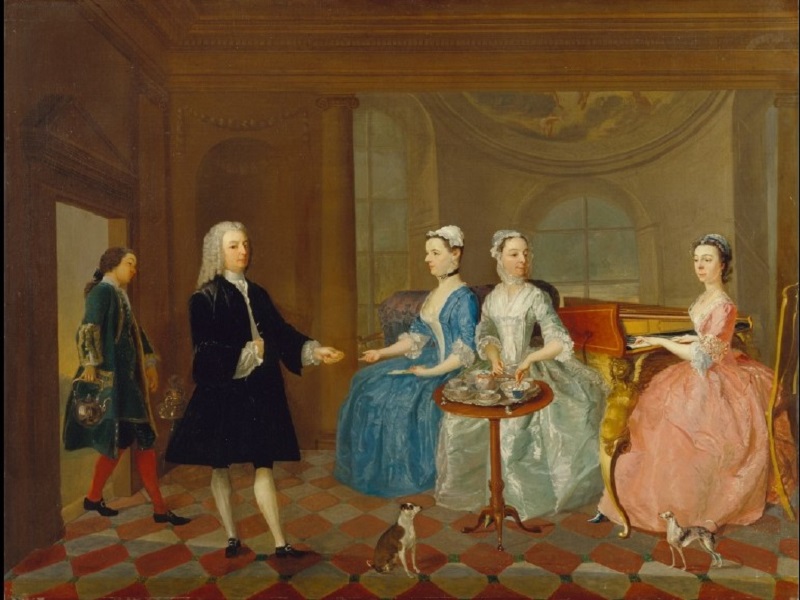
Tea time 1810
But back then it was quite an outlandish request; one that sent ripples through time that we still feel today. For example, our Princess asked for a dish of tea, not a cup. It’s a small but surprisingly important difference. One of the things we love most about High Tea, one of the things that make it so special is being served our tea in pretty bone china cups and saucers. So in this blog post, we’ll explore the extraordinary story of the tea service. Believe it or not, it took a Royal wedding, four hundred years, two Empires, and the Industrial Revolution to create the tea cups and saucers that we now associate with High Tea.
Here is the main points in the blog post, tap to skip to a section
- Who was this Portuguese Princess and why is she important in the tea cup story
- Why tea became all the rage in London society
- How the Tea Cup Handle was invented
- Why tea cups come with saucers
- How the general public could finally afford tea

Who was this Portuguese Princess and why is she important in the story?
Catherine of Braganza (1638 – 1705) travelled to England in 1662 to marry King Charles II. The marriage couldn’t have been more important because it was meant to consolidate the newly-restored Stuart dynasty. Charles famously adored beautiful, vivacious women and women adored him. His unfortunate bride, however, was a disappointment: rather plain, with slightly protruding teeth, frumpy, and religious. Like most women it seems, Catherine adored her husband. He couldn’t return her affections or faithfulness but that’s a whole other story……
The point of this particular story is that Catherine was our royal bride. She alighted from the ship that momentous day and stunned the welcoming party by asking for a dish of tea. You see, four hundred years ago, tea hadn’t yet caught on in England whereas Portugal had a long-established trading Empire with China and Japan and the nobility had adopted the ancient custom of tea drinking. While tea was not unknown in seventeenth-century England it was mainly considered medicinal.
The welcoming party were all set to offer their new Queen a glass of weak ale so her unexpected request for tea created a minor panic. The day (and no small amount of official English embarrassment) was saved when a member of her entourage supplied them with some tea. And so the English were introduced to tea drinking in a whole new way.



England becomes obsessed with all things tea
Then as now, nothing set a fashion quite like a royal endorsement. Gossip about Catherine and her cuppa spread like wildfire amongst the English nobility and suddenly tea became all the rage in London society. Anyone who was anyone just had to be seen sipping tea like the royal bride and the demand for tea and tea dishes shot up dramatically. Of course this was music to the ears of the directors of the East India Company (established by Royal Charter in 1600 to compete with the Portuguese themselves for the incredibly valuable spice trade from the East). They saw a golden opportunity to cash in and began importing tea, fine porcelain tea pots and dishes. Blue and white porcelain tea bowls were certainly made in China around 200 BC. Now, alongside tea itself, they had become the East India Company’s single most valuable commodity.
Related: The Art of brewing the perfect tea
But at this point tea and “tea things” were incredibly expensive, making tea the reserve of the rich and titled. In the next post we’ll take a look at the story of the tea caddy, developed to keep this expensive commodity under lock and key but for now, we’ll keep tracing the story of how we came to be enjoying out tea from delicate cups and saucers we love so much. The East India company traded with China, Japan and then India; becoming increasingly wealthy before more or less being amalgamated into the British Empire as we know it.
Meanwhile, by the mid-eighteenth century, drinking tea was all the rage with the London A-listers of the day who flocked to take tea at the uber-fashionable outdoor tea gardens at Ranelagh Gardens and Vauxhall where they could be entertained with live music as they sipped their tea in style. And by 1870 fast sailing ships called (Tea Clippers) were landing huge amounts of tea onto the London docks. Take the famous Cutty Sark, for instance, which made eight voyages that very year, returning from her first trip alone laden with almost 1500 tonnes of tea.
So far our story has featured a royal wedding and two Empires. But what does the Industrial Revolution have to do with the development of the tea cup and saucer?
Why the tea cup handle was invented
There is a clue in the amount of tea being imported by the 1870s – demand was still increasing. But how? Surely the upper classes could only consume so much, especially given how expensive tea, pots and bowls were because tea was consumed in expensive imported porcelain bowls or in English silver. Tea drinking had begun with the upper classes imitating royalty. It continued to grow as middle-class ladies clamoured to copy them; serving tea in their comfortable drawing rooms to their suitably impressed visitors.
This demand created a market for enterprising English potters like Josiah Wedgwood to create their own, more affordable tea services. The Chinese served their tea warm but the English preferred their tea hot. It has been suggested that the influential architect Robert Adam thoughtfully suggested adding a handle to the bowl to avoid ladies burning their fingers; thereby creating the cup as we know it. Or, perhaps it was an adaptation to the new English sets which also added milk and sugar bowls to cater for English tastes. Either way, it was certainly a good idea!
Adding a little “saucery”
Ever wondered why tea cups come with saucers? Saucers changed in both size and function at around the same time. Originally much smaller, the saucer was used to rapidly cool a small amount of tea for easier drinking and would be sipped from the saucer itself. A saucer also prevented scorches and drips from ruining expensive tea tables. These days, we use the saucer to hold the cup securely and comfortably and provides a resting place for our spoon.
Bring on the revolution!
The next major change occurred during the Victorian Industrial Revolution. The manufacture of English tea sets brought down the price of tea sets over the nineteenth century and the price of tea came down too, due to the introduction of steam ships which were not only faster but also took a shorter route via the new Panama Canal. Soon even factory workers could afford to make tea part of their everyday lives and potters catered to them by producing cheaper china pots, cups and eventually, mugs.
As more and more of the population could afford tea, so it lost much of its association with royalty, elegance and style. But from the 1990s High Tea became fashionable once more. We’ve got to admit, nothing feels quite a special as our bespoke tea blends, served with prettiest cups and saucers. Combine it with delicious treats like family scone recipe, delicate sandwiches and cakes and we have the perfect High Tea for today. And absolutely nothing beats sharing that experience with family and friends; for a very special occasion, romantic indulgence, or just a glamorous catch-up with the girls.
Here at Aimee Provence, we are honoured to provide our elegant High Tea Parlour as a unique venue for your own special High Tea. And we take genuine pride, not just in creating the most delicious, quality High Tea, but also in adding that extra special touch of selecting the very prettiest tea china available. Why? Because we know that you enjoy a High Tea experience fit for a royal bride.




What a lovely thought producing this information. Well done and so interesting. I have a pewter tea pot from 1725 and every time I use it I think of all the people who had held the teapot handle over the years.
You’re welcome Frances! Delighted that you enjoyed reading our article on the history of the tea set. I’m sure that your tea pot has heard many fond stories over the years?
Loved this story. My Nanna would always drink her tea from the tea cup saucer! I now know why… could never work it out as a child and was never told the reason… fascinating, thank you
Thank you for taking a moment to read our blog, Rhonda – nice to know that you enjoyed reading the article and that we brought up fond memories of your Nanna’s tea-drinking days.
I have enjoyed High Tea with you three times and loved the experience.
Sadly I don’t live on the Sunshine Coast, but I visit family there regularly.
The story of tea, cup and caddy was very interesting.
Thanks for the invitation, hopefully will visit again soon